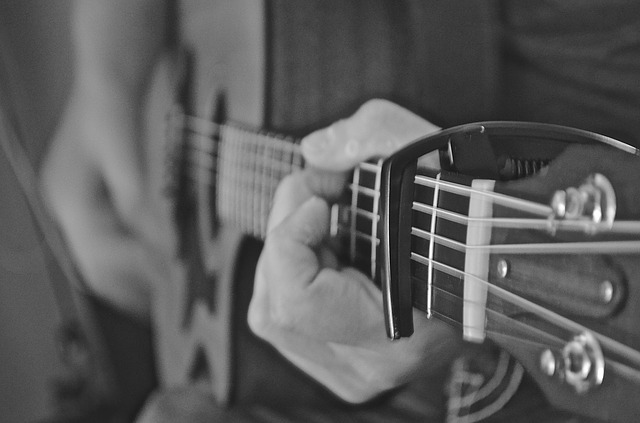A guitar ‘Capo’ is a very handy little device that can aid guitar players in many playing situation. The basic function of a capo is pretty simple, that is to raise the pitch of the guitar so that a guitar player can play in different keys without having to change the chord fingerings.
How to use a ‘Capo’
To use a capo is easy, all you have to do is clamp the capo on desired fret of the guitar. The fret being ‘capoed’ now become the new ‘nut’ position and if you’re not sure what a ‘nut’ is, it is the white thing at the beginning of the guitar fretboard just after the tuners. Everything you play now are raised in pitch according to what fret the capo was placed, for example; if you place the capo on the 2nd fret, your ‘C chord’ now will sound as a ‘D chord’. However, there is one little requirement that you need to meet in order to be able to place the capo on the right fret. You will need to know the names of the 6th and 5th strings notes on every fret which is not hard at all. Below are the names of the notes on the 6th and 5th strings from the open string up to the 12th fret;
FRET(NOTE):
6TH STR = O(E) – 1(F) – 2(F#) – 3(G) – 4(G#) – 5(A) – 6(A#) – 7(B) – 8(C) – 9(C#) – 10(D) – 11(D#) – 12(E)
5TH STR = O(A) – 1(A#) – 2(B) – 3(C) – 4(C#) – 5(D) – 6(D#) – 7(E) – 8(F) – 9(F#) – 10(G) – 11(G#) – 12(A)
Why would you use a ‘Capo’?
There are a few situation where using a capo will be helpful in your playing.
1. To play in different key without changing chord fingerings.
This goes back to the basic function of the capo itself. If you are a beginner who haven’t learned or not yet able to play closed position chords(Barre chords), placing the capo on certain fret will enable you to play your open position chords higher up the neck which automatically place you in different key which otherwise will requires you to play a barre chord instead. And why would you want to play in different key? Well imagine a situation where you are learning a song that is in the key of ‘D’ and one song in particular is “Canon In D” which chord progression goes as follows:
| D – A – | Bm – F#m – | G – D – | G – A – |
The ‘Bm’ and ‘F#m’ are closed position chords which you may not be familiar with, so instead of struggling with it you can place a capo on the 2nd fret and play these chord progression instead:
| C – G – | Am – Em – | F – C – | F – G – |
Since the capo was placed on the 2nd fret, the sound produced are the same as if you were playing in the key of ‘D’.
This method is actually not limited to beginners only. Many professional singers songwriters who perform their songs with a guitar prefer to use a capo so that they can adjust the key of a song to the range of their voice while still be playing in open position chords. This can help them concentrate more on singing without worrying to much about hard chord fingerings.
2. To loosen up the strings to make it easier for the fingers.
In my teaching experience often time a beginning student will have a hard time pressing the strings if the guitar was tuned in standard tuning. And it’s even harder if the guitar that they bought was not setup or build properly such as having ‘high action'(Strings too high above the fretboard). So I would normally suggest that they lower the tuning to reduce the strings tension and place a capo to make up for the lost in pitch. There is an additional benefit too, now that the ‘nut’ being moved higher up the neck also means that the frets are getting narrower and this somehow makes learning chords much more easier..:)
3. To Arrange fingerstyle guitar arrangements in open position higher up the neck.
For the more advance player, using a capo also means that they can use the open bass strings further up the neck to their advantage. This is very useful for arranging fingerstyle guitar arrangements in various keys higher up the neck while still have access to the sustaining open bass strings(strings 6,5 and 4) to support the melodies. The open bass strings are normally more limited to the key ‘E’, ‘A’ and ‘D’.
The ‘Capo’ may just be a simple device but no doubt it is a must have accessories for guitar players, beginners and professionals.


